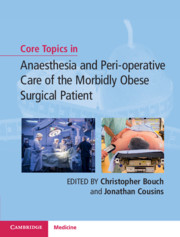Book contents
- Core Topics in Anaesthesia and Peri-operative Care of the Morbidly Obese Surgical Patient
- Core Topics in Anaesthesia and Peri-operative Care of the Morbidly Obese Surgical Patient
- Copyright page
- Contents
- Contributors
- Preface
- Abbreviations
- Section 1 Background to Obesity, Epidemiology and Anthropology
- Section 2 Pathophysiology of Obesity
- Section 3 Pre-operative Assessment and Preparation
- Section 4 Intra-operative Management
- Section 5 Post-operative Care
- Section 6 Bariatric Surgery
- Index
- References
Section 2 - Pathophysiology of Obesity
Published online by Cambridge University Press: 24 September 2018
- Core Topics in Anaesthesia and Peri-operative Care of the Morbidly Obese Surgical Patient
- Core Topics in Anaesthesia and Peri-operative Care of the Morbidly Obese Surgical Patient
- Copyright page
- Contents
- Contributors
- Preface
- Abbreviations
- Section 1 Background to Obesity, Epidemiology and Anthropology
- Section 2 Pathophysiology of Obesity
- Section 3 Pre-operative Assessment and Preparation
- Section 4 Intra-operative Management
- Section 5 Post-operative Care
- Section 6 Bariatric Surgery
- Index
- References
- Type
- Chapter
- Information
- Core Topics in Anaesthesia and Peri-operative Care of the Morbidly Obese Surgical Patient , pp. 29 - 58Publisher: Cambridge University PressPrint publication year: 2018



